TL;DR: This is complicated, even for Sassi. Simplified individual recipe links (which won’t work until after the “Continue reading” jump): Cookie Butter Shortbread (Vegan) | Sticky Pumpkin-Cookie Butter Blondies, Maybe? (Vegan) | Hazelnut Meringue Cookies (Vegan!!!)
The Saga of the Pumpkin Noisette Fancies
When it comes to holiday baking, I have a mission: Bake something delicious for the two vegans on my team. Bake sales and dessert buffets are sad for vegans unless someone is looking out for them. I’m a militant omnivore, but I like to take care of my people, and I like the challenge of baking without eggs or dairy products.
I don’t bake desserts very often. I like to, and I have good technique, and the creative combinations I think up usually work pretty well. But having lots of flour and sugar in the house isn’t the best idea for my blood lipids. Things I like to bake tend to involve a lot of active time, oven-watching, and making an overflowing sinkful of dirty dishes (and then having to wash them). I don’t often have the wherewithal. But I certainly do enjoy the excuse of a holiday party to bake something impressive. Previous forays have included no-bake hazelnut drop cookies, chocolate-peppermint cupcakes, and chocolate-coconut cupcakes. (I might get around to writing up that last one, eventually. They were good. “A triumph,” according to one taster. But this year was all-new.)
Inspiration, Part 1: Pumpkin and Cookie Butter
Have you tried cookie butter? It is pulverized spice cookies (“speculoos“) mixed with palm and canola oils, with a bit more sugar and some emulsifiers. I am hesitant to write more about it. I can’t, in good conscience, recommend that you try it if you haven’t already. Cookie butter is not a good nutritional decision, no matter what kind of orthodoxy you subscribe to. (It’s shockingly easy to be vegan and still eat food that will stop your heart.) I wouldn’t go as far as the anonymous author “D.C.” on the useful blog Eating At Joe’s, who says “Would I buy it again: I would fight you for the last jar if I had to. I would gouge your damn eyes out.” But I get where D.C. is coming from. Cookie butter is horrifying and beautiful.

{Digression: Trader Joe’s also sells cookie butter sandwich cookies, which are butter cookies with cookie butter in between. Not enough cookie butter in between, though, so I made an improvement: Two butter cookie/cookie butter sandwich cookies, with more cookie butter in the middle. I did this once. I am not proud. [Well, I am proud of being able to write the (entirely grammatical!) expression “butter cookie cookie butter sandwich cookie cookie butter sandwich cookies.”] End digression.}
Also this year, I started adding pumpkin [footnote 1] puree to Greek yogurt as a snack. I get bored of plain yogurt, and most flavored yogurts have too much sugar or artificial sweetener or (gag) modified food starch and gelling agents. (I like jellied things that a lot of people don’t, such as aspic, but I don’t want my yogurt to even hint at gelatinousness.) Pumpkin puree is smooth and slightly sweet and full of vitamins and fiber. So, it has taken on a new versatility in my head, and I’ve been looking for places to use it. I should acknowledge that Trader Joe’s also has something called “pumpkin pie spice cookie butter,” but I did not see it until this concept was well underway. (Plus I couldn’t have used it, because it isn’t vegan.)
Inspiration, Part 2: Magic Bean Water
Some time ago, I read about aquafaba—a newly-coined term [footnote 2] for the soupy-slippery brine from canned or cooked beans (particularly garbanzos/chickpeas). It seemed bizarre and nigh-miraculous. With my vegan team members plus a nephew and at least two friends with allergies to egg whites, I am always on the lookout for egg alternatives. But I never thought I would be able to replace egg whites in something as fundamental as meringue.
I’m delighted to be wrong.
I had seen pictures. I had read the FAQ. It still didn’t seem real. I tested this out at Jeanne’s house (while Adam and Colin were also visiting, and using Jeanne’s sister-in-law Kate’s KitchenAid mixer) on the weekend of December 10-11, 2016. I drained the liquid out of two cans of chickpeas, poured it into the steel bowl of Kate’s KitchenAid, attached the whisk, put in 1/2 tsp of cream of tartar, and turned the machine on. Adam and I, heads together, watched the meringue build up in volume, and turn opaque. I added sugar, slowly; the mixture turned glossy, and held a soft peak. Adam looked at me in slightly accusatory wonder and whispered, “Shut. Up.”
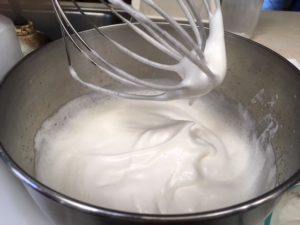
This is some Rumpelstiltskin-level alchemy, right here. Spinning straw into gold seems frankly more plausible, since I’m pretty sure “spinning straw into gold” is a metaphor for making linen from flax.
Aquafaba meringue does seem to take slightly longer to whip to peak stage than egg whites, but not agonizingly so.
I took a third of that meringue and folded it into a combination of pumpkin puree and cookie butter, which produced a somewhat-too-wet but completely edible pudding-ish layer (“Shut the *hell* up!”)
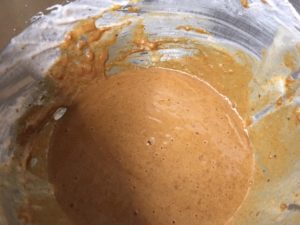
I mixed another third of the meringue with hazelnut meal and cinnamon; this produced a collapsed, thin, but beautifully crisp and tasty dacquoise. (I might be using that word incorrectly. A traditional dacquoise is a cake, of which the meringues are one element. Too bad. I like saying it.)
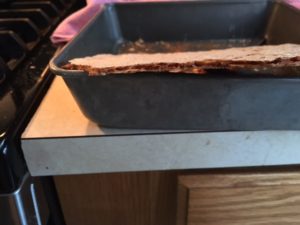
The last third of the meringue went into a Pyrex container which I held in the fridge overnight to see if it would shrink (slightly) or weep (not at all), and then baked it plain the next day. It held up beautifully, and kept its height.
All three aquafaba tests were revelations, in their own way. I tweaked the recipes mentally and started working for real on Dec. 11 for an office holiday party on the 16th. (Hilariously, neither of my vegan team members ended up coming to the party. I saved them some.)
Inspiration, Part 3: Entremets
Sometime in the summer of 2016, I clickholed my way to a post in which Scott Bryan, entertainment editor for Buzzfeed UK, described trying to execute all the technical bakes from The Great British Bake-Off [footnote 3]. The post made me sick with laughter, and in August and September I binge-watched three seasons of the show. One episode featured a patisserie item called an “entremet” (ehn-tra-MAY)—which literally means “a thing that is placed between other things,” and functionally appears to mean “a highly creative, tiny, fiddly, fancy cake with many layers of different textures.” An entremet is not what I ended up with, being as I bake so seldom that I had to borrow a jellyroll pan from my sister to execute this week’s extravaganza. But they were definitely the inspiration for my small three-layered treats.
What I did end up with was these:
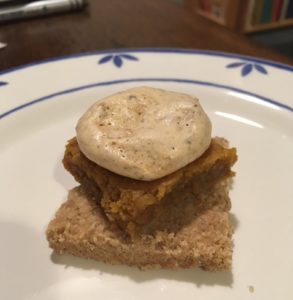
They are cookie butter shortbread bites with a layer of pumpkin-cookie butter filling, topped with hazelnut meringue. (I am so fancy. I wave my fancy flag.) If you can stick with me, and you have three evenings free in a row, or a weekend with nothing else going on, they might be worthwhile. I’m really not sure. They are delicious, but totally impractical. Keep in mind I’m perfectly happy to make a relatively simple stew over four days, and I *still* think this is a ridiculous process. To replicate it, you would have to make a batch of too-thin shortbread, and then use the crumbs from that to make the middle layer, which goes on top of a second (thicker) batch of shortbread. I am not telling you to do that.
However: The shortbread on its own is dead easy and fantastically delicious. And the meringues are lovely, and worth trying just for the mind-blowing way the aquafaba actually turns into meringue despite being not at all made of eggs. The pumpkin filling is quite nice as well, but would be fairly pointless on its own, I think. [Unless you made it into little individual puddings with a crunchy-crispy topping, like a gingerbread crumble. Or added some more flour or cookie crumbs, some liquid (almond milk? apple juice?), and some baking powder to make a sturdier, less sticky blondie-type object.]
Here’s What I Did (or “How to Do”? Narrative Verb Tenses are Tricky.)
Sorry about the verb tenses. Some of this was written while it was happening, and other parts were retrospective. (We still haven’t gotten to the follow-able recipes. You can skip this rambly part if you want.)
Originally I had been contemplating a single layer of dacquoise, but then realized that cutting it would be problematic. Meringue is shattery. I decided to make individual kisses instead. My guess as to why the test-dacquoise yielded such a flat result is that if you use too fine a grind, the oil from the hazelnuts collapses the structure of the meringue. Plus adding cinnamon seemed like it could be microscopically bubble-popping. I hand-chopped 4oz hazelnuts and mixed them with 1T cornstarch before adding to the meringue.
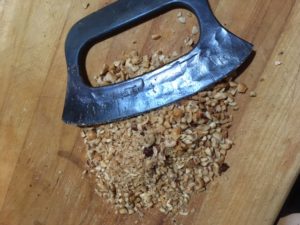
Quality Assurance Testing
Reviews!
Epilogue
The Follow-Able Recipes
This makes a lot—48 1.5-inch squares in a 13″ x 17″ jellyroll pan (the kind of cookie sheet with a raised rim all the way around). Smaller batches work fine. I leave the math and adjusted baking times to you.
- 4 cups all-purpose flour
- 1/2 cup granulated sugar
- 2 tsp cinnamon (preferably Ceylon, but use what you have)
- 1 tsp cardamom
- (Optional: You could try other spices if you like, like maybe a hint of cloves or nutmeg or ginger.)
- 1 tsp salt
- 3/4 cup cookie butter
- 1.25 cups Earth Balance Original Buttery Spread or other spreadable (not whipped) margarine
- Preheat oven to 300 degrees.
- Line a jellyroll pan with baking parchment.
- Measure dry ingredients into a large mixing bowl and whisk with a wire whisk or fork to combine evenly.
- Add cookie butter and margarine.
- Toss dry ingredients over the shortenings, and rub/toss between your fingertips until mixture is the consistency of slightly coarse sand. (You could also use a pastry blender for this. Maybe you could pulse it in a food processor but I haven’t tried that.)
- A handful of it, when squeezed, should hold together firmly, but fall apart when you pinch it. (If it falls apart with just a gentle poke, add a tablespoon or two more of each shortening and work through.)
- Spread the sandy mixture evenly in the pan and press down firmly, particularly in the corners.
- Dock into whatever size squares you want—i.e., poke a grid of holes with a fork.
- Bake for 50-55 minutes, until edges begin to darken and the center is firm to the touch.
- Allow to cool in pan for 10 minutes, then slide a broad spatula under the parchment and slip the whole sheet of shortbread onto a clean cutting board. Cut into pieces along the docked lines.
- Try not to eat them all at once.
- Pumpkin puree: A 15-oz can or 16-oz box
- 2 tsp vanilla extract
- 1/3 cup cookie butter
- 1/2 cup aquafaba (the liquid out of a can or two of chickpeas)
- 1/2 tsp cream of tartar
- 1/2 cup granulated sugar
- 1 cup cookie crumbs (either from shortbread recipe above, or try gingersnaps or graham crackers or something)
- Put pumpkin puree in a sieve; set sieve in a bowl; and refrigerate overnight.
- Open your cans of chickpeas to check whether the liquid needs straining or concentrating (if it’s cloudy or has hulls in it, it needs straining).
- On the day: Line a 9×13 baking pan with baking parchment.
- Preheat oven to 375.
- In a small skillet, cook down the water that came out of the pumpkin to one tablespoon–bring to a boil, then reduce heat and let it cook down, watching carefully after the first 10-15 minutes (it will darken and get sticky)
- In a medium mixing bowl, mix pumpkin syrup, pumpkin puree, vanilla, and cookie butter until well-combined. (You can microwave the mixture on low power for a couple of minutes to make mixing easier.)
- Fold cookie crumbs into pumpkin mixture.
- In a large bowl, whip the aquafaba with the cream of tartar (either in a stand mixer or with a hand-held mixer) until foamy. Add the sugar one tablespoon at a time, and continue whipping until firm peaks form.
- Fold one-third of the meringue into the pumpkin mixture and mix until evenly combined; then fold in the rest of the meringue more gently.
- Bake at 375 for 35-40 minutes until a toothpick inserted in the center comes out clean (the mixture will be pulling away from the sides, and the top will be cracked; this is fine.)
- Flip out of pan onto clean cutting board and cut into however many squares you want. (A pizza cutter works very well.)
Hazelnut Meringue Cookies (Also Vegan!!)
Start these the day before you want them.
- 1/2 cup aquafaba
- 1/2 tsp cream of tartar
- 1/2 cup granulated sugar
- 4 oz hazelnuts
- 1 T cornstarch
- Day before: Check your aquafaba in case it needs straining/reducing.
- Toast hazelnuts for 30-40 minutes in a 300-degree oven, stirring every 10 minutes, until the skins start to crack off and the nutmeats are deep gold.
- Cool. Rub the hazelnuts between your hands to remove most of the skins.
- Day of: Chop the hazelnuts medium-fine (most pieces the size of aquarium gravel or the candy called Nerds).
- Put the chopped nuts in a small bowl, sprinkle the cornstarch over them, and stir to combine. (You’re trying to coat the nut granules with starch.)
- In a large bowl, whip the aquafaba with the cream of tartar (either in a stand mixer or with a hand-held mixer) until foamy. Add the sugar one tablespoon at a time, and continue whipping until firm peaks form.
- Gently fold chopped nut mixture into meringue.
- Preheat oven to 250 degrees.
- Line a baking sheet* with baking parchment and either pipe or drop by rounded 1/2 teaspoonfuls. (*You could probably get two baking sheets’ worth out of this amount, but I had an Incident with the clogged piping bag so I’m not sure.)
- Bake at 250 for about an hour, until slightly golden, fragrant, and firm to the touch.
- Cool on pan for 5 minutes, then slide parchment onto a wire cooling rack (cookies will continue to crisp as they cool, and make charming crackling noises as they do so).
- When completely cool, peel them off the parchment and store in an air-tight container (they hold well for at least a week this way).